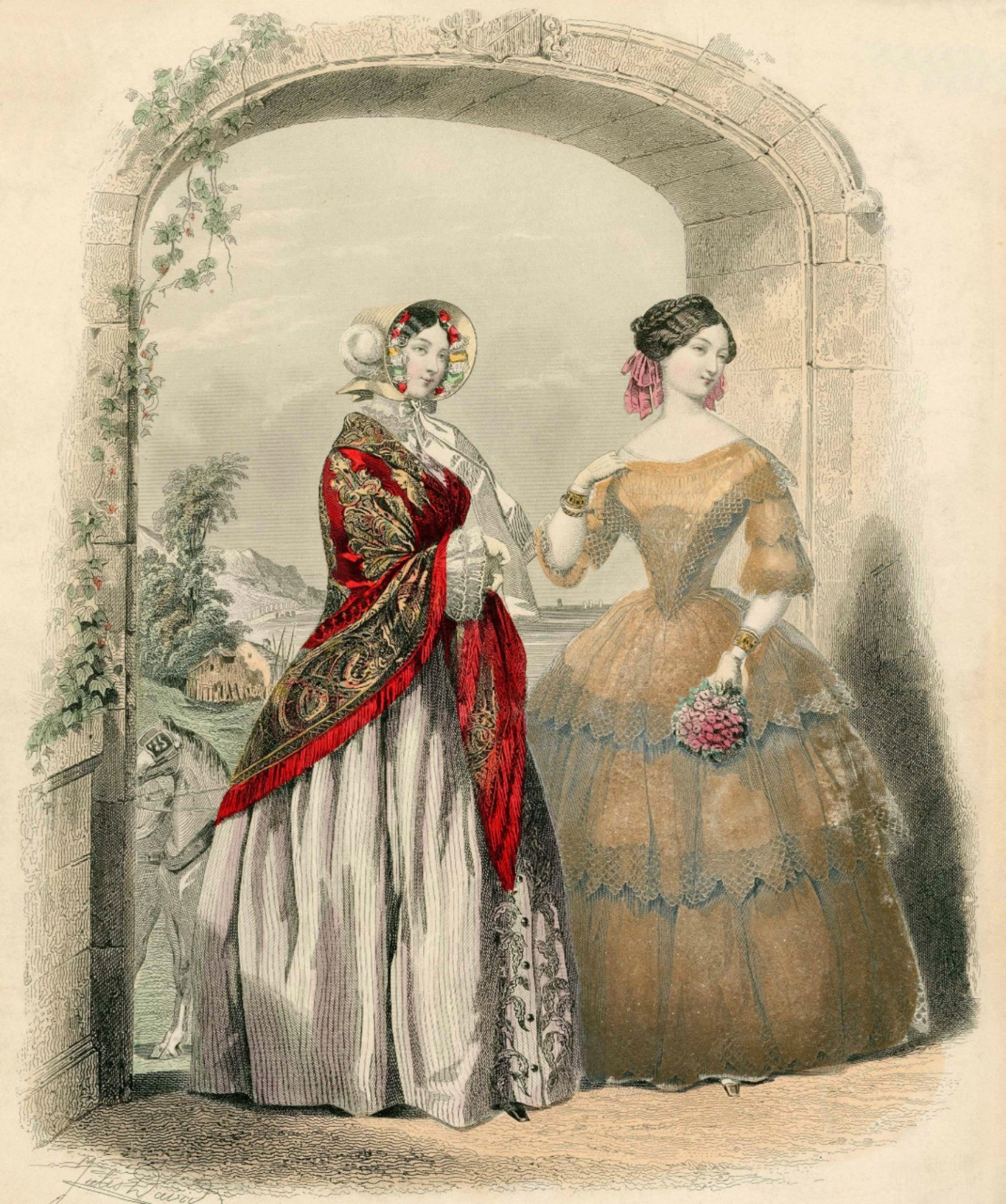- youtube
- bluesky
- Home
- About
- Costume Journal
- Membership
- Conference & Events
- Grants & Awards
- News & Social
Tis' the season to wrap up warm and in this weeks blog, historical novelist and fashion historian, Mimi Matthews, discusses the most fashionable of all cold weather essentials in the nineteenth century, the cashmere shawl.
During the autumn and winter months, as the temperature dropped and the weather grew colder, many nineteenth century ladies relied on their shawls to keep them warm. The basic style of wear was relatively unchanged throughout the century. This fact made shawls no less fashionable. Indeed, in an article in the 1878 edition of The Art Journal, Percy Fitzgerald (M.A., F.S.A) calls the shawl one of “the most artistic” forms of dress. Much of a shawl’s beauty was owing to the elegance of its draping. Wore in an oversize fashion, not only did shawls “answer the purpose of covering and keeping the figure warm,” they naturally fell into “graceful and meaning folds,” which required “no artificial training or shaping.”
Cashmere or India shawls in particular held a special place in the early to mid-nineteenth century ladies’ wardrobe. An 1841 edition of The World of Fashion reports a decided preference for “India shawls” on account of the rich elegance of their designs, which were “more calculated to distinguish the lady than any other part of her wardrobe.” It even goes so far as to proclaim that:
An India shawl is as indispensable to the tout ensemble of a well-dressed lady, as the bien soigne appearance of the coachman and footman is to her equipage.
As garments designed to provide warmth, both at home and abroad, the utility of the cashmere shawl was unrivaled. However, it was the rare beauty of their native craftmanship that guaranteed the cashmere shawl’s status as a fashionable cold-weather essential. In his 1898 book Fashion in Paris, Octave Uzanne states that:
This elegant product of Indian industry is indispensable to every French woman; and so high a value does she set upon it, that one would almost believe its tissue invested with some magic spell.
A cashmere shawl was as luxurious as it was warm. The wool that went into making it came from the sheep in the Kashmir region of India. It wasn’t easy to come by, especially as the century progressed and the shawl-weaving industry in the Valley of Kashmir was decimated by war and famine. According to Uzanne, a genuine cashmere shawl was “an extraordinary rarity, and an object of universal envy,” one that “played a conspicuous part in the richest and most refined society in Paris.” Similarly, in her 1892 book Old Cashmere Shawls, Margaret Rives King states:
There has never been a time when the offering of a Cashmere shawl was not considered the rarest and most beautiful gift that could be made to woman; and now more than ever to be valued must such a gift be, when we consider that this once beautiful and lovely region—the poet’s own land—is now desolated by tyranny and famine…
In many ways, a cashmere shawl was an investment piece. It combined luxury and practical purpose with fashionable longevity. It’s staying power assured that, once purchased, the shawl would give decades—if not generations—of use. In an 1889 article in The Woman’s World, Ella Hepworth Dixon states that, throughout the century, “costly cashmere shawls invariably formed part of a bride’s trousseau.” Cashmere shawls were also considered an “essential” part of the “corbeille de marriage,” a traditional gift basket, “which every Frenchman who respects himself offers to his bride.” These same richly-made cashmere shawls frequently achieved heirloom status. As Uzanne explains:
A Cashmere shawl was looked on, in France, as a valuable inheritance to be transmitted to posterity. The remark, ‘It is a piece of furniture,’ was often heard. As a matter of fact, our great-grandmothers’ shawls have been passed on from one generation to the next, and even nowadays their astonishingly delicate texture and wonderful colouring delight the curious eyes of those who care to turn over the contents of the carved wardrobes, still standing in many an ancient country house.
Whether worn by a Regency era lady sitting inside by the fire or by a Victorian lady strolling the grounds on a chilly morning, the cashmere shawl was a cold-weather essential. Not, perhaps, as effective against the worst of the elements as an umbrella or a waterproof cloak, but (at least in my opinion) eminently more beautiful. The sort of timelessly elegant outerwear that’s as functional today in its original form as it was in the nineteenth century.
Sources
Dixon, Miss Ella Hepworth. “On Cloaks.” The Woman’s World, Vol. 2. London: Cassell & Company, 1889.
Fitzgerald, Percy, M.A., F.S.A. “The Art of Dressing and of Being Dressed.” The Art Journal, Vol. XVI. London: Virtue & Company, 1877.
King, Margaret Rives. Old Cashmere Shawls. Cincinnati: Robert Clarke & Co., 1892.
Uzanne, Octave. Fashion in Paris: The Various Phases of Feminine Taste and Aesthetics from the Revolution to the End of the XIXth Century. London: William Heineman, 1898.
The World of Fashion, and Continental Feuilletons, Vol. 2. London: Simpkin, Marshall, and Co., 1841.
USA Today bestselling author Mimi Matthews writes both historical nonfiction and award-winning proper Victorian romances. Her novels have received starred reviews in Publishers Weekly, Library Journal, Booklist, Kirkus, and Shelf Awareness, and her articles have been featured on the Victorian Web, the Journal of Victorian Culture, and in syndication at BUST Magazine. In her other life, Mimi is an attorney. She resides in California with her family.
Check out Mimi’s website, Facebook, Twitter and Instagram. For more fascinating fashion history articles check out our blog, or if you are as passionate about fashion history as we are why not become a member today.
Image gallery

Ball Gown and Cashmere Shawl, Le Moniteur de la Mode, 1850, Met Museum

Woman with Cashmere Shawl and beribboned Gown by François Courboin, 1846